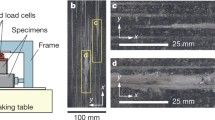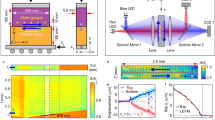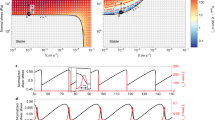Abstract
In this paper we report results obtained from various friction experiments under direct and oblique shear loading conditions. We used four rock types of varying brittleness (quartzite, anhydrite, limestone, pyrophyllite) with different surface roughness. The observations concentrate on the time span several milliseconds before dynamic failure occurs. During this period a premonitory, unstable phase of slip (slip 2) occurs. This differs importantly from a premonitory, stable process (slip 1) with durations of hundreds of seconds. On smooth surfaces slip 2 is usually observed with ductile rocks and less reliably with brittle rocks. Slip 2 is mostly accompanied by acoustic emissions, which increase in rate of occurrence and in magnitude until the stick-slip event. Foreshocks are observed during approximately 50% of the slip 2 events on rough surfaces. Foreshocks far exceed the “acoustic noise level”, which is also prevalent before stick-slip events on rough surfaces. In the direct shear experiment, where two faults are being loaded simultaneously, in about 20% of the cases precursory slip 2 was observed on the opposite side on which the final stick-slip event occurred.
Similar content being viewed by others
References
Brace, W. F., andByerlee, J. D. (1966),Stick-slip as a Mechanism for Earthquakes, Science153, 990–992.
Brown, S. R., andScholz, C. H. (1985),Broad Bandwidth Study of the Topography of Natural Rock Surfaces, J. Geophys. Res.90, 12,575–12,582.
Byerlee, J. D. (1967),Frictional Characteristic of Granite Under High Confining Pressure, J. Geophys. Res.72, 3639–3648.
Byerlee, J. D., andBrace, W. F. (1968),Stick-slip, Stable-sliding, and Earthquakes. Effect of Rock Type, Pressure, Strain Rate, and Stiffness, J. Geophys. Res.73, 6031–6037.
Byerlee, J. D., andSummers, R. (1975),Stable Sliding Preceding Stick-slip on Fault Surfaces in Granite at High Pressure, Pure Appl. Geophys.113, 63–68.
Dieterich, J. H. (1978),Preseismic Fault Slip and Earthquake Prediction, J. Geophys. Res.83, 3940–3948.
Dieterich, J. H. (1979),Modeling of Rock Friction. 1. Experimental Results and Constitutive Equations, J. Geophys. Res.84, 2162–2168.
Igarashi, G., andWakita, H. (1990),Ground Water Radon Anomalies Associated with Earthquakes, Tectonophys.180, 237–254.
Logan, J. M. (1977),Creep, stable sliding and premonitory slip, Proceedings of Conference II,Experimental Studies of Rock Friction with Application to Earthquake Prediction, USGS Menlo Park, California, 205–237.
Ohnaka, M., Kuwahara, Y., Yamamoto, K., andHirosawa, T.,Dynamic breakdown processes and the generating mechanism for high-frequency elastic radiation during strike-slip instability, InEarthquake Source Mechanics (eds. Das, S., Boatwright, J., and Scholz, C. H.) (Geophysical Monograph 37, Maurice Ewing Volume 5, Amer. Geophys. Union 1986) pp. 13–24.
Ohnaka, M., andKuwahara, Y. (1990),Characteristic Features of Local Breakdown Near a Crack-tip During Stick-slip Shear Failure, Tectonophys.175, 197–220.
Okubo, P. G., andDieterich, J. H. (1984),Effects of Physical Fault Properties on Simulated Faults, J. Geohphys. Res.89, 5817–5827; Geophys. Res.90, 7821–7826.
Power, W. L., Tullis, T. E., andWeeks, J. D. (1988),Roughness and Wear During Brittle Faulting, J. Geophys. Res.93, 15268–15278.
Scholz, C., Molnar, P., andJohnson, T. (1972),Detailed Studies of Frictional Sliding of Granite and Implications for the Earthquake Mechanism, J. Geophys. Res.77, 6392–6406.
Sobolev, G. A., Spetzler, H. A., andSalov, B. G. (1978),Precursors to Failure in Rocks While Undergoing Anelastic Deformation, J. Geophys. Res.83, 1775–1784.
Spetler, H. A., Sobolev, G. A., Salov, B. G., Getting, I. C., andKoltsov, H. (1981),Surface Deformation, Crack Formation and Acoustic Velocity Changes in Pyrophyllite Under Polyaxial Loading, J. Geophys. Res.86, 1070–1080.
Spetzler, H. A., Sobolev, G. A., andGetting, I. C.,Holography in laboratory experiments pertinent to rock deformation and failure, InLaser Holography in Geophsics (ed. Takemoto, S.) (Ellis Horwood Limited, New York 1889) pp. 31–105.
Stesky, R. M., Brace, W. F., Riley, D. K., andRobin, P.-Y. F. (1974),Friction in Faulted Rock al High Temperature and Pressure, Tectonophys.23, 177–203.
Wakita, H.,Precursory changes in ground water prior to the 1978 Izu-Oshima-Kinkai earthquake, InEarthquake Predictions, An International Review (eds. Simpson, D. W., and Richards, P. G.) (Amer. Geophys. Union 1981) pp. 527–532.
Weeks, J. D., andTullis, T. E. (1985),Frictional Sliding of Dolomite: A Variation in Constitutive Behavior, J. Geophys. Res.90, 7821–7826.
Author information
Authors and Affiliations
Rights and permissions
About this article
Cite this article
Spetzler, H., Sobolev, G., Koltsov, A. et al. Some properties of unstable slip on rough surfaces. PAGEOPH 137, 95–112 (1991). https://doi.org/10.1007/BF00876891
Received:
Revised:
Accepted:
Issue Date:
DOI: https://doi.org/10.1007/BF00876891




